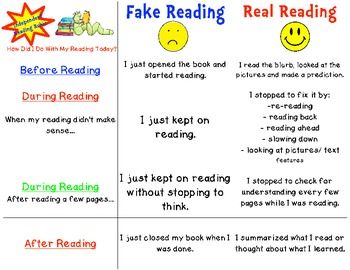20 April 2016
Newsletter Articles
Principal’s Report
Welcome back to Term two. I trust that everyone had an enjoyable Easter. Term two is traditionally a very busy one in schools and this term is shaping up to be similar. There are many exciting events that will occur during the term.
Term 1 Centurions
It was very pleasing last week on assembly to be able to reward 44 students with 100% attendance certificates for Term 1. These students were at school each and every day during Term 1 and have made “every day count”, giving themselves the best opportunity to succeed with their learning. In addition to their certificates, these students will also receive ten “Starbucks” which they can add to their tally for Term 2.
During Term 1 we had an average attendance rate of 90.2% which is an increase from the same period last year. As you know, our target for attendance is 92%, and it is a goal of the school to achieve this target. I would like to thank the parents and caregivers for their support of school attendance and would like to remind students that it is important to be at school to make “Everyday Count” so that gaps in their learning do not develop, and they give themselves the best chance possible to succeed.
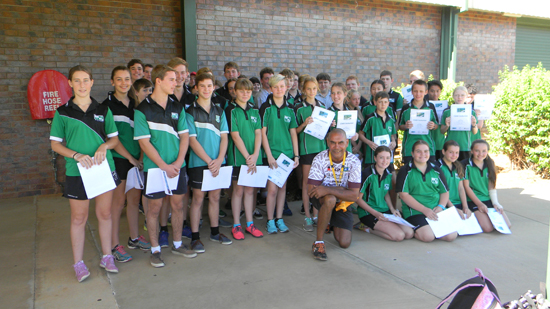
Facility Upgrades
Over the holidays, our school has seen some upgrades occur to the teaching and learning environment as we continue to strive for providing the best facilities possible for our students. The following facility upgrades have occurred:
- The carpet has been replaced in the Library, which has enhanced this facility.
- Our Trade Training Centre also had carpet installed in the two classrooms, and this certainly has improved the acoustics of these rooms.
- D14 has hard carpet installed.
- You will have also noticed that the painting of A Block has nearly been finished and very soon the contractors will move onto B block to paint this building also.
- The roof on B Block has also been replaced over the holidays.
Staffing
I would like to welcome Ms. Elizabeth Nicholls to our school as our Local Relief Teacher. Liz is an experienced teacher having taught in both the Northern Territory and New South Wales systems. Mrs. Vanessa Alexander will also be joining our staffing team as Local Relief Teacher on a Friday. Vanessa will fill in some of the role that Leah Stirton was performing for us in Term 1.
White Gloves Experience
On the 12th of April, we were very lucky to have the State Library of Queensland bring their exhibit, “The First World War Treasures” to our school. The exhibit allowed our students the opportunity to get up close and personal with a selection of treasures from the First World War such as letters, diaries, medals and photographs. This was a great opportunity for our school as many of the exhibits are normally only available to be viewed at the State Library in Brisbane.
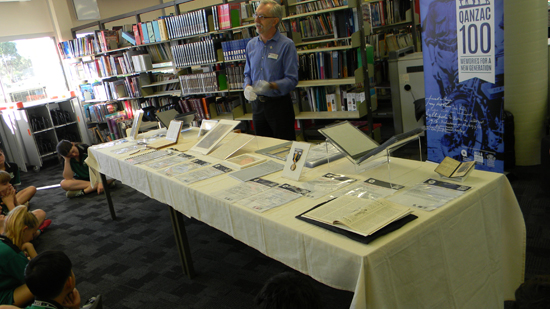
Term 1 Interim Reports and Parent Teacher Interviews
Last week our Term 1 interim reports were mailed out to all families. The term one report is an opportunity for students to see how they are progressing in their subjects and if necessary make any adjustments to their study patterns during term 2. On Tuesday the 26th of April our Parent Teacher Interviews will be held at the Library beginning at 3.30 pm. A letter with the information needed to book the interviews accompanied each student report. If you need the school office to book your interviews for you, please make contact and we can do this for you.
Parents and Citizens Association News
The executive of the Parents and Citizens Association was elected at the Annual General Meeting, which was held in March. I am pleased to announce the executive of the P and C is as follows:
President - Julie Frousheger
Vice President - Tanya Carr
Secretary - Jo Springall
Treasurer - Michelle Aspinall
Uniform Convenor - Karen Mackie
RREAP Representative - Virginia McDonald
On behalf of the school, we would like to thank these people for their commitment to the P and C, and we look forward to working with the P and C Executive and Committee across 2016. The next meeting of the P and C will be held on the 11th of May at 5.30 pm in the Conference Room located within the Administration building.
Anzac Day
This Friday during period four we will have our school Anzac Day service. This is an important event in the school calendar as we pause to remember the Anzacs landing at Gallipoli 101 years ago. I would like to thank Mr. Bernie Matthews for his organisation of this event.
The school will be participating in the town services that are being held on Monday. Last year we had a fantastic turnout to the Anzac Day parades, and it would be great if we could repeat this. The details are as follows:
- Dawn Service – those students who can attend, please gather at the town hall park prior to 5.15 am for the official Dawn Service.
- Town March – students need to assemble at the Neighbourhood Centre in Alfred St by 9.15 am on Anzac Day. The march is scheduled to start at 9.40 am. Students are requested to be in their best school uniform.
I look forward to seeing our students representing Charleville State High School on Monday the 25th of April.
Reminder to be safe when travelling on or near buses
With another school term underway, we’d like to remind all students and parents to please be safe when travelling on or near buses.
A significant number of school students in Queensland travel on buses to attend school. All students have the right to a safe and enjoyable journey, and their safety is our number one priority.
Ensuring students safe travel on or near buses is a shared responsibility which brings together the efforts of students, their parents/carers, schools, bus drivers and bus operators. When travelling on or near a bus, there are some safety tips you should follow to ensure a safe journey
http://translink.com.au/sites/default/files/assets/resources/travel-information/school-travel/safety-tips-for-students.pdf
A Code of Conduct for School Students Travelling on Buses is also available to provide students and parents/carers with information about how to travel safely on buses.
http://translink.com.au/travel-with-us/school-travel/getting-to-and-from-school
It is important to us that every day, in every classroom, every student is learning and achieving. Charleville State High School thanks you for your support in this partnership.
Marcus
Teaching and Learning @ CSHS
I would like to welcome everyone back to Term 2. This is going to be another busy term but there are many great things to look forward to. We have QCS Masterclass in Roma, NAPLAN, Anzac Day ceremonies, School Photos, Cross Country, many curriculum-based excursions, and much more.
Year 7 and 9 Students: NAPLAN (National Assessment Program – Literacy and Numeracy)
If you have a student in Year 7 or 9 they may be getting a little anxious regarding the NAPLAN tests coming up on Tuesday 10 May, Wednesday 11 May and Thursday 12 May. A letter and information sheet has been sent home to parents with the 2016 Interim (Term 1) Report cards.
The National Assessment Program – Literacy and Numeracy (NAPLAN) tests were first implemented in May 2008 when national tests were held in literacy and numeracy for all students in Australia in Years 3, 5, 7 and 9.
What is the purpose of NAPLAN?
While it is acknowledged that the NAPLAN tests can cause anxiety for some students, the purpose of NAPLAN is to assess the skills of all Australian students in literacy and numeracy against national minimum standards.
What is tested?
A series of (5) FIVE tests will assess areas of literacy and numeracy.
The following areas of literacy are assessed in three papers:
- Language conventions - spelling, grammar and punctuation
- Writing - knowledge and control of written language
- Reading - comprehension.
In numeracy, students are tested across two papers (calculator and non-calculator) and the content areas assessed are:
- Number
- Measurement, chance and data
- Space
- Algebra, function and pattern (formal algebra for Year 9 only).
Results from the tests will provide important information about your student's progress in literacy and numeracy. Following the tests, schools and students will receive a statement of performance in relation to the national minimum standards.
What do students need to do?
Students need to try their hardest, focus on their own work and turn up to each exam on time. Year 7 students will sit their tests in the library and Year 9s will be located in A Block. Both year levels have been preparing across Term 1 and recently sat trial exams. These trial exams provide feedback for our staff on student progress and areas to focus on, as well as to familiarise students will the processes that will take place on May 10th, 11th and 12th.
For further information about NAPLAN and the tests please do not hesitate to contact the school or go to the links below.
https://www.qcaa.qld.edu.au/p-10/naplan/general-information
http://www.nap.edu.au/
WHAT ARE OUR YEAR 11 AND 12 STUDENTS, AND THEIR CURRICULUM, WORKING TOWARDS?
Easy answer - the Queensland Certificate of Education (QCE). The amount of opportunities provided today to senior students means that that there are so many other things they can work towards. For example, a school-based traineeship/ apprenticeship, work experience, vocational education certificate, sporting goals etcetera. The only thing hampering the success of our senior students today, and the attainment of their QCE, is their own drive and determination.
What is a QCE?
The Queensland Certificate of Education (QCE) is the minimum requirement expected to be achieved by all school leavers at the end of a senior course of study. Year 11 & 12 students accrue points for the subjects that they are passing in their senior years and are required to accumulate a minimum of 20points to obtain a QCE. We encourage all parents with students in Year 11 and 12 to contact the school if they would like to further discuss this certificate so they can help support their students as much as possible.
http://www.qcaa.qld.edu.au/589.html
How are we supporting your student to attain their QCE?
1. QCE tracking
After each reporting period we analyse the results and determine if students are on track for their QCE or not. From this analysis we develop plans for individual students to attain their QCE, after conversations with students, parents and staff. These conversations have begun for Year 11 and 12 students, with Mr Kohli (HOD Maths/ Science/ Senior Schooling) and myself working with students most at risk to get their direction back on track. This process is repeated after each reporting period to ensure that everyone is following a path that best meets their future needs.
79% of our Year 12 cohort is on track for their QCE for 2016. Our target is 100% QCE attainment and 79%, while a good start, falls short of the mark. With the help of a wide range of staff each student is provided every opportunity to achieve this important outcome. It is also important to remember that this data is based on projected outcomes, that is, what students would gain if these results were achieved at the end of their senior studies in November 2016. This means that there is still a great deal of opportunity to get back on track. There is no reason for any student not be able to attain their QCE if they are truly committed to their own education and putting in the effort required for future options to be open to them
2. Student Accountability Program [Year 10-12]
The Senior Student Accountability Program, or SSAP, is a key element of our Responsible Behaviour Plan for senior students at CSHS that forms the basis of the safe and effective learning environment. The program enables students to monitor their own behaviour, attendance and completion of required assessment during their post compulsory studies.
How does SSAP work?
Each student will start with 0 points at the beginning of each year of Year 11 and 12. If students regularly attend school, arrive on time, complete and submitted all assessment/ exams on time and communicate clearly with the school if there are any issues ahead of time then the SSAP will not impact on your student. In fact, such students will be rewarded through the School Wide Positive Behaviour System (SWPBS). However, if not then the following points will be accorded to students:
|
2 points |
Per each late arrival to school without an acceptable reason and documentation (e.g. note, phone call from parent to the office) |
|
4 points |
Per each day of absence that is not explained within (5) five school days |
|
15 points |
Per each piece of assessment this is not submitted, or sat, on time, or unable to be marked against syllabus criteria prior to the draft/ due date set each semester. The assessment schedule is provided to all students to help avoid this situation occurring. *Senior students are able to apply for extension to such dates with the appropriate paperwork, ahead of the date and with valid and documented reason/s. |
3. Other support networks (apart from the classroom)
There are many avenues to support students at Charleville State High School including:
Guidance Officer: Kate Trulson
Heads of Department -
Sebastian Kohli (Maths/ Science)
Cassandra Kohli (English/ Humanities)
Sabrina Goodingham (Junior Secondary/ HPE/ LOTE/ The Arts)
Bernie Matthews (Technology/ VET)
Year level coordinators:
Year 7 – 9 Katherine Goult and Sam Barrow
Year 10-12 Leighton Webb and Jemma Day
Careers/ Transition advice: Sue McDonald
Youth Support coordinator: Jenny Peacock
School based Youth Health Nurse: Jen Sellin
Chaplain: Les Penrose
There is also a study/ homework group that meets on a Tuesday afternoon that all students can attend. Students interested in attending this session need to see Mr Kohli for the parent approval form.
Thank you for your continued support of your student, the school and the educational process. If you would like any further information regarding the topics above please don’t hesitate to contact the school. Together we can make a difference in the lives of our future leaders.
Regards
Donna
Visual Arts Excursion A Success
Donna Reynolds Shows Senior Art Class How it’s Done
This term, the senior art class is exploring illustration techniques for children’s books. As part of this unit, we have had the privilege to work with local artist Donna Reynolds, who illustrated the children’s book The Flood Grungies. Year 11 and 12 students interviewed Donna at length regarding her design process and character designs for the book. They also had the opportunity to participate in a 90 minute practical workshop, where Mrs Reynolds helped students to design their own characters, which were painted in water colour.
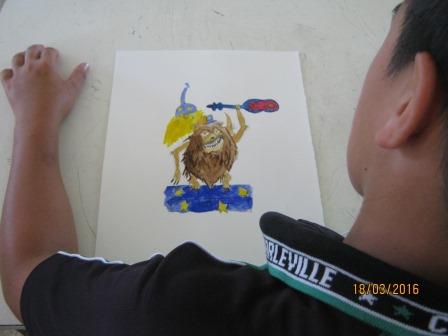
White Glove Experience
Last, Wednesday 13th April, in preparation for ANZAC Day, junior Humanities students and Year 11 and 12 Modern History students were lucky enough to participate in a White Glove Experience: First World War Treasures, QANZAC 100: Memories for a new generation. This experience, organised by Mr Matthews, allowed our students to experience first-hand, primary sources from World War One. Niles Elvery, Regional Coordinator of the QLD State Library, and his team, brought all the way from Brisbane a range of photographs, diaries, letters, pilot license and even a war medal from World War One. These rare and fragile sources contained stories of courage, resilience, sacrifice and duty to share the real life experiences of our World War One heroes. All students donned white gloves so they could have the privilege to touch and examine these rare and genuine artefacts from World War One. After a brief introduction on World War One and a background to all of the primary sources our students were thrilled to carefully dive in with their white hands to thoroughly examine these rare pieces. The favourite pieces were photographs from Charleville showing the intersection of Alfred and Wills Street, and Alfred Street itself during the war times. There is nothing quite like touching such a significant item which is over one hundred years old, and understanding what experience our ancestors went through. This experience is one which will remain in the memories and hearts of our students for years to come.
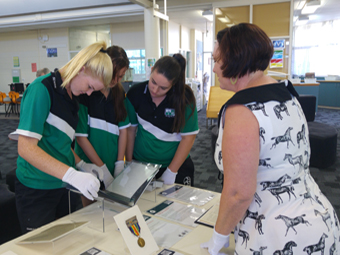
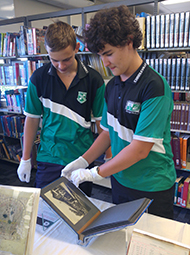
Sabrina Goodingham
HOD Junior School / HPE / The Arts / LOTE
Info from the GO
April is Autism Awareness Month
Autism is a lifelong developmental condition that affects, among other things, the way an individual relates to his or her environment and their interaction with other people. The word ‘spectrum’ describes the range of difficulties that people on the autism spectrum may experience and the degree to which they may be affected. Some people may be able to live relatively normal lives, while others may have accompanying learning challenges and require continued specialist support.
The main areas of difficulty are in social communication, social interaction and restricted or repetitive behaviours and interests. Some children display unusual sensory interests such as sniffing objects or staring intently at moving objects, sensory sensitivities including avoiding everyday sounds such as hair dryers, vacuum cleaners etc. It is estimated that approximately one in 100 people has autism, which is almost 230 000 Australian people. This means that more than 12 000 students with autism are enrolled in Queensland State Schools. Autism affects four times as many boys than girls.
This year the Queensland Government launched Australia’s first Autism Hub to provide students with autism, their families and schools across the state, with more support. Located in Brisbane, the $2 million centre offers expert advice, training and resources to parents, educators and health professionals. Seven regional autism coaches have also been appointed; ensuring professional support is available state-wide.
http://www.education.qld.gov.au/autismhub
April is Autism Awareness Month and our school is committed to working with families and services to support students with autism and ensure that they get the best possible start in life. Towards the end of April, students will be requested to ‘Go Blue for Autism’. Further details will be provided in the coming few weeks.
Adapted from https://www.autismspectrum.org.au and QLD State Schooling information.
Reading Corner
Dependent and Independent Readers:
In a previous newsletter edition I outlined key characteristics of struggling or dependent readers. This week, I will outline what an independent or good reader does.
The most obvious difference between these two types of readers is that independent readers will read confidently, fluently and will comprehend what they have just read. This means that they can retell and answer questions about the text.
A key difference between the two is that independent readers may still struggle with difficult/new/unknown text BUT they have and use strategies to work through this. You will see independent readers do the following (Beers, 2003):
- Recognise that the purpose for reading is to get meaning;
- Figure out what is confusing them;
- Set goals for getting through the text;
- Use a range of comprehension strategies such as: predicting, summarising, questioning and visualising;
- They make inferences about the text;
- They use their prior knowledge to help understand the text;
- They recognize most words automatically;
- They re-read if the idea is lost.
At CSHS we are trying to create independent readers both at a whole school level with the activities that all teachers do in class but also at a more intensive level through the program that I run – LLI and our MultiLit program. In the next edition of the Reading Corner I will start to outline how you can work toward moving from a dependent to an independent reader (for your child/ren). Start to think about where your child/ren might sit and how you might like to help them.
Happy reading!
Ange Stirton
